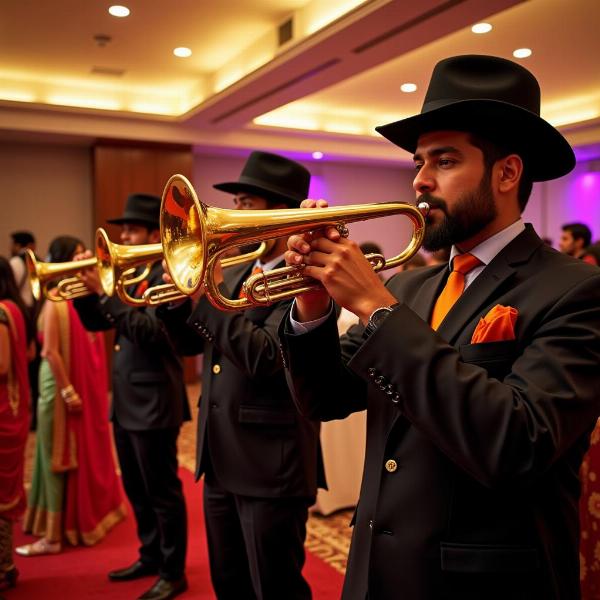Understanding the meaning of “brass band” in Hindi involves more than just a simple translation. It’s about grasping the cultural context, the musical nuances, and the historical significance of these vibrant ensembles. This guide explores the different facets of “brass band” in Hindi, from its literal translation to its cultural implications in India.
What Does “Brass Band” Mean in Hindi?
The most common Hindi translation for “brass band” is पीतल वाद्य बैंड (peetal vadya band). पीतल (peetal) means brass, वाद्य (vadya) refers to musical instruments, and बैंड (band) simply means band. While this literal translation is accurate, it doesn’t fully capture the essence of a brass band in an Indian context.
The Cultural Significance of Brass Bands in India
Brass bands hold a special place in Indian culture, often associated with celebrations, processions, and religious ceremonies. From weddings and festivals to political rallies and funerals, the resounding melodies of brass instruments have become an integral part of the Indian soundscape. These bands often adapt Western musical styles, blending them with traditional Indian melodies and rhythms, creating a unique fusion that reflects the country’s diverse musical heritage.
Different Types of Brass Bands in India
While the term “brass band” generally refers to ensembles primarily using brass instruments, there are variations across different regions of India. Some bands incorporate woodwind instruments like clarinets and saxophones, while others might include traditional Indian instruments like the shehnai or dholak. This blend of Western and Indian instrumentation creates a unique sonic tapestry that is both familiar and distinctly Indian.
 Indian Wedding Brass Band
Indian Wedding Brass Band
Brass Bands in Bollywood and Popular Culture
Brass bands also feature prominently in Bollywood films and popular music, adding a vibrant and energetic dimension to the soundtrack. Often used to depict celebratory scenes, processions, or even moments of heightened drama, the powerful sound of brass instruments adds a distinct flavor to the cinematic experience.
The Evolution of Brass Bands in India
The history of brass bands in India is intertwined with the country’s colonial past. Introduced during the British Raj, these musical ensembles were initially associated with military and ceremonial functions. Over time, they were adopted and adapted by Indian musicians, eventually becoming an integral part of the country’s musical landscape.
Brass Band: A Symbol of Celebration and Tradition
Whether it’s a wedding, a festival, or a religious procession, the presence of a brass band signifies a joyous occasion, bringing people together through the power of music. This tradition continues to thrive in modern India, showcasing the enduring appeal of these vibrant ensembles.
Conclusion
The term “brass band” in Hindi encompasses more than just its literal meaning. It represents a vibrant musical tradition deeply embedded in Indian culture, signifying celebration, community, and a unique blend of Western and Indian musical influences. From its historical roots to its contemporary presence in Bollywood and popular culture, the brass band remains a powerful symbol of India’s rich and diverse musical heritage.
FAQ
-
What is the literal translation of “brass band” in Hindi?
The literal translation is पीतल वाद्य बैंड (peetal vadya band). -
Are brass bands only used for celebrations in India?
While primarily associated with celebrations, they are also used in other contexts like funerals and political rallies. -
What types of instruments are used in Indian brass bands?
They typically use brass instruments, but some also incorporate woodwind or traditional Indian instruments. -
Do Indian brass bands play only traditional Indian music?
No, they often play a mix of Western and Indian music, creating a unique fusion. -
Where can I find brass bands performing in India?
You can find them at weddings, festivals, religious processions, and other public events. -
Are brass bands still popular in India today?
Yes, they remain a popular and vibrant part of Indian culture. -
How did brass bands come to India?
They were introduced during the British Raj and subsequently adopted and adapted by Indian musicians.
Related Articles
About Meaning-Hindi.in
Meaning-Hindi.in is your trusted partner for all your Hindi translation needs. We offer a wide range of professional translation services, specializing in business, legal, technical, website localization, educational, and specialized translations. Our expert team ensures accuracy, cultural sensitivity, and timely delivery for all your projects. Need a quick translation or a specialized linguistic solution? Contact us today at [email protected] or call us at +91 11-4502-7584. Let Meaning-Hindi.in bridge the language gap for you!